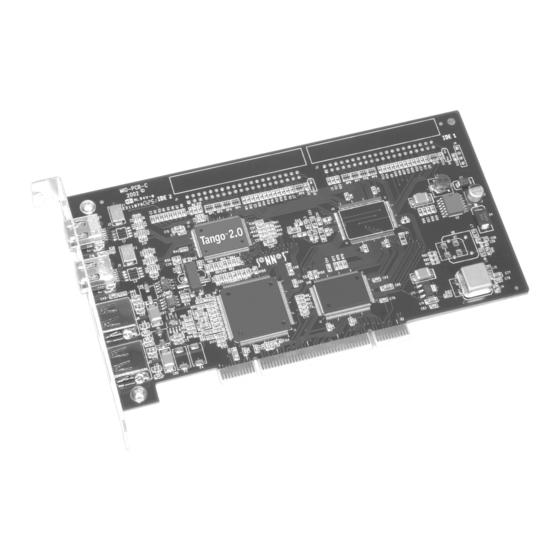
Table of Contents
Advertisement
Quick Links
®
FireWire
/USB 1.1/2.0 PCI Combo Adapter Card
Quick Start Guide for Tango 2.0
Compatibility
At this printing, the Tango 2.0 may be used with any Mac
computer with an available PCI slot that meets the following requirements:
• Macintosh Computer Requirements:
®
Power Macintosh
or Macintosh clone computer running Mac OS
through Mac OS X Version 10.3.x. Mac OS X Version 10.2.8 or higher is
required for high-speed USB 2.0 support.
• PC Requirements:
IBM PC/AT or compatible desktop computer with Pentium
II (or equivalent) or better running Windows 98 SE (Second
Edition), Windows Me (Millennium Edition), Windows 2000,
or Windows XP. Windows XP with Service Pack 1 installed is
required for high-speed USB 2.0 support.
You Should Have
The following items should be included in your product package:
• One Tango 2.0 PCI Combo Adapter Card
The following items may be required for installation:
• Medium Phillips screwdriver
• One or more FireWire (IEEE 1394) cables (sold separately)
• One or more USB cables (sold separately)
• One or more USB hubs (sold separately)
System Requirements
The following software drivers are required:
• FireWire driver software*
• USB driver software*
• Tango Firmware Patch—ONLY for installation of the Tango 2.0 in Power
Macintosh 5500 or 6500, or in Twentieth Anniversary Macintosh computers.
(Download the Tango Firmware Patch from www.sonnettech.com/support/tango;
install it before installing FireWire and USB drivers.)
.
Support Notes:
We recommend you make a backup of important information on your
system's current hard drive(s) prior to installing new hardware or software.
When handling computer products, you must take care to prevent components from being
damaged by static electricity. Before opening your computer or removing parts from their pack-
ages, always ground yourself first by touching a metal part of the computer, such as a port
access cover, and work in an area free of static electricity; avoid carpeted areas. Handle all elec-
tronic components by their edges, and avoid touching connector traces and component pins.
Technical knowledge may be required to gain access to the expansion card slots in certain
computer models. We recommend you first consult your computer's user manual. If you feel
you are unable to install the computer hardware, contact a qualified technician.
* Depending on your operating system, you may need to install these drivers; instructions follow.
Remember to register your product online at http://registration.sonnettech.com to be informed of future upgrades and product releases.
Software updates and links are available from the Sonnet web site at www.sonnettech.com. • Online support form available at http://supportform.sonnettech.com
Sonnet Technologies Customer Service hours are Mon.–Fri., 7 a.m.–5 p.m. Pacific Time • Customer Service Phone: 1-949-472-2772 • E-mail: support@sonnettech.com
Sonnet Technologies, Inc., California USA • Tel: 1-949-587-3500 Fax: 1-949-457-6350
©2003 Sonnet Technologies, Inc. Revised 2004. All rights reserved. Sonnet, the Sonnet logotype, Simply Fast, the Simply Fast logotype, and Tango are trademarks of Sonnet Technologies, Inc. Macintosh and Mac are trademarks
of Apple Computer, Inc., registered in the United States and other countries. Other product names are trademarks of their respective owners. Product specifications subject to change without notice. Printed in the USA.
QS-FWUSB2-E-E-062804
®
®
or Windows
OS
®
9.0
®
Advertisement
Table of Contents

Summary of Contents for Sonnet TANGO 2.0
-
Page 1: System Requirements
Sonnet Technologies, Inc., California USA • Tel: 1-949-587-3500 Fax: 1-949-457-6350 ©2003 Sonnet Technologies, Inc. Revised 2004. All rights reserved. Sonnet, the Sonnet logotype, Simply Fast, the Simply Fast logotype, and Tango are trademarks of Sonnet Technologies, Inc. Macintosh and Mac are trademarks of Apple Computer, Inc., registered in the United States and other countries. - Page 2 4. Remove the Tango 2.0 card from its packaging. 5. Install the Tango 2.0 into the PCI slot; make sure the card is fi rmly seated and secured. 6. Close your computer and carefully replace its cover.
- Page 3 Installation Steps—Mac OS Computers Mac 9.2 through OS X Version 10.2.6 The drivers that enable the Tango 2.0 to support FireWire (400), and the drivers that enable it to support all USB devices at USB 1.1 speeds are installed automat- ically when you upgrade your Mac operating system software to 9.2 through...
- Page 4 Installation Steps—Mac OS Computers Mac OS 9 (Existing Installation) If Mac OS 9.0.x is installed in your computer, you must download and install the appropriate FireWire and USB driver software. Please note, if your system has built-in USB and FireWire ports, you may skip these steps. 1.
- Page 5 4. Locate an available PCI slot inside your computer and, if present, remove its port access cover from the rear of the computer. 5. Install the Tango 2.0 card into the PCI slot; make sure the card is fi rmly seated and secured.
- Page 6 Depending on your system’s configuration before you install the Tango 2.0 (for example, you’ve previously installed a USB card), some of the drivers required to support the Tango 2.0 card may have already been installed. If this is the case, you may not need to perform some of the steps listed.
- Page 7 Installation Steps—Windows PCs Windows 98 SE (continued) Windows 7. When the next Add New Hardware Wizard (NEC USB Open Host Controller) window appears, click Next. 8. When the next window appears, select “Search for best driver for your device (Recommended),” and then click Next. 9.
- Page 8 ADB keyboard and mouse connected to your system to support such functionality. • Mac Users: When the Tango 2.0 is installed in a pre-G3 Macintosh computer, connected FireWire drives cannot be used as the system startup (boot) drive.
















Need help?
Do you have a question about the TANGO 2.0 and is the answer not in the manual?
Questions and answers